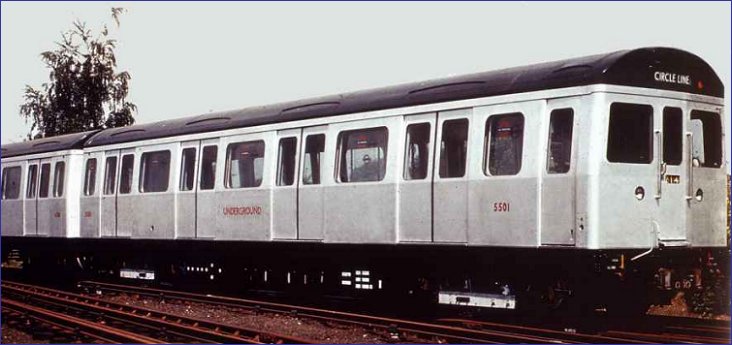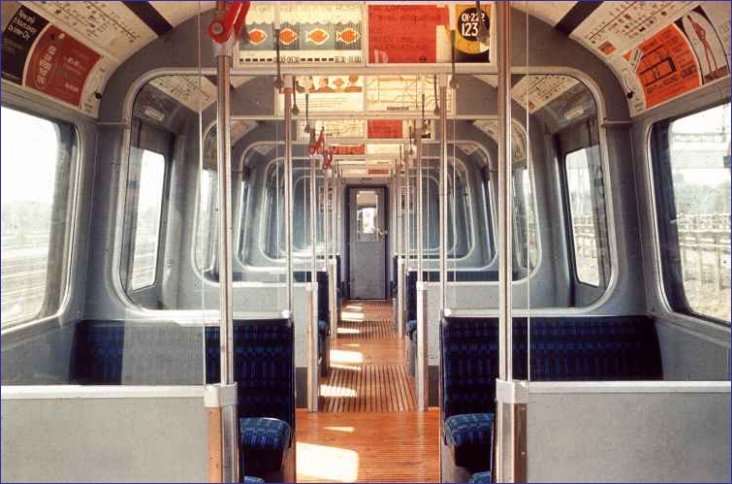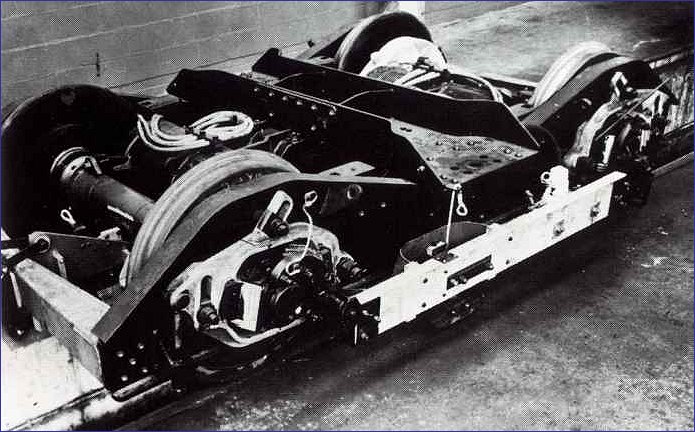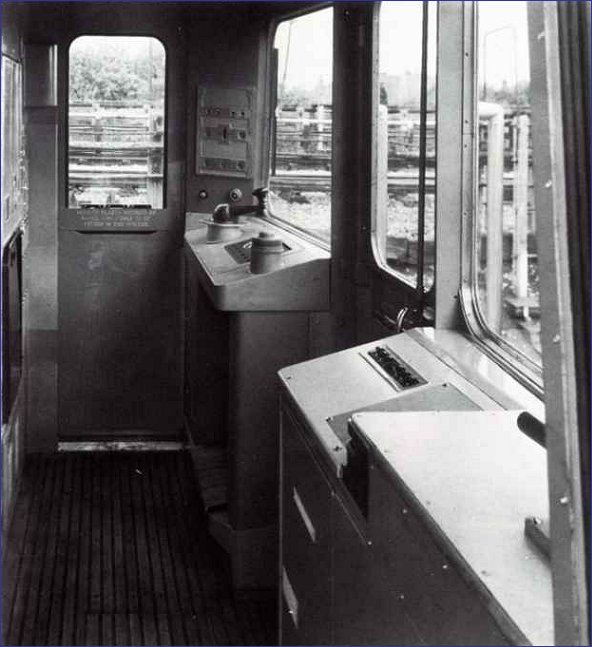Photos - C Stock in Original Condition
Fig.1: Exterior of C Stock as
Delivered

Driving end of 2-car unit of C Stock as
delivered in 1970. This was the first stock on the Underground to have four sets of
double doors per car side and air operated, sliding cab doors. The cars were
designed for the heavily used Circle Line and they needed specially deep solebars to
support the four wide door openings in the car bodyside. The drivers cab door also
had pneumatic air seals, designed to seal the door to prevent draughts when it was closed.
They often failed and were removed during refurbishment.
Another new feature of these trains was that
they were equipped with air suspension. The "Metacone" suspension units
kept the car floor at the same level regardless of load by increasing or decreasing the
air pressure while the car was at stations with the doors open. The air signal was
used to adjust acceleration and braking according to load. The system was removed
during refurbishment and replaced with plain rubber suspension units.
Back to C Stock Page
To the Top of this Page
Fig. 2: Interior of C Stock as
Delivered

The interior of the C Stock as originally
delivered into service. Apart from a pair of seats at the trailing ends of cars,
all seats were transverse, with a pair on each side of each doorway. All were
protected by draught screens. Note that car ends were originally without end
windows.
Some of the vertical handrails on the left of
the picture have the old type of red emergency handles. These act directly on the
train line pipe (as the brake pipe is called on the Underground) so that, if operated, the
train stops. There was no warning for the driver and no override to allow the train
to be driven to the next station. The system was much abused by hooligans and led to
the present arrangement being adopted.
The floor is grooved maple wood, used by the
Underground since the 1920s until the early 1990s. In its original condition, it was
varnished to give it the beautiful golden finish seen here. Needless to say, it
didn't last long like that in service.
Smoking was allowed on Underground trains until
9th July 1984. Before then, some cars were allocated as "NO
SMOKING". On the C Stock, two trailers on a 6-car train were
"smokers", so the third trailer had to have "NO SMOKING" signs on the
windows. These were removable so that the correct signs could be displayed when
trains were reformed. Small plastic brackets were glued to windows to carry the
signs if required.
The C Stock originally had internally
illuminated advertisement frames, mounted across the car at each draught screen, as shown
here. The idea was imported from the 1967 Tube Stock, as a means of increasing
advertising revenue. These were removed at refurbishment, the cost of maintenance
virtually eliminating the extra revenue.
Back to C Stock Page
To the Top of this Page
Fig. 3: C Stock Bogie in
Original Condition

The original C Stock bogie. It had steel
side frames and aluminium headstocks. The primary suspension was the traditional (by
then) London Underground chevron shaped rubber blocks mounted in cast aluminium yokes,
bolted on the inner ends and fitted with variable slots at the outer ends.
The shoebeam was hung between the
axleboxes. The rope operated shoe lifting gear can be seen where the rope is
supported by the end of the bogie bolster.
The bogie bolster has two, large, widened ends
where the secondary suspension units were mounted. The were combined rubber/air
cylinders known as "Metacones". The air pressure in the Metacones allowed
the car to be levelled as the load changed.
When car doors were opened the air suspension
system was unlocked so that the loading and unloading of passengers could be detected and
the air pressure adjusted to keep the body at a constant height. When the doors
were closed, the system was locked. The change in air pressure was used to adjust
the acceleration and braking of the train so that it could be constant regardless of
weight.
The Metacones were a maintenance worry and the
bogies themselves were weakened by poor track conditions over the years. In the
early 1970s, the bolsters had strengthening brackets fitted under them where the Metacones
rested.
The bogie frame design was the same for motor
cars and trailers but the motor versions each had two traction motors, as shown
here. The trains had 50% axles motored.
The bogies frames were replaced during the
refurbishment of 1990-94. The Metacones were replaces by rubber suspension units
similar to the "Christmas puddings" used under the D Stock and the air operated
load/weigh system for the traction and braking was removed. Since the mercury
retardation controllers of the e-p braking system also allow for changes in train weight,
it was really an unnecessary duplication and led to variable braking performance.
Back to C Stock Page
To the Top of this Page
Fig. 4: Cab of C Stock in
Original Condition

The C Stock driver's cab in original condition
as equipped for two-person operation. The door controls were on the rear wall so
that they could be used by the guard working from the rear cab.
Note the control desk on the left (far) side of
the cab with the combined traction/brake controller (CTBC) locked in the shut down
position. Beyond the CT/BC on the nearside corner panel is the whistle and window
wiper control. The whistle was moved to the control desk shortly after the trains
entered service.
The cab side doors are air operated - the first
on London Underground. They were also originally equipped with air operated blow up
anti-draught seals. Draughty cabs were a constant source of complaint from drivers
who had to sit or stand in cold cabs for up to 4½ hours. The air seals activated
automatically when the door closed and released when it was opened. They were
another source of trouble in themselves as they were unreliable and the seals often got
damaged. They were removed when the trains were refurbished.
The cab was originally designed with future
conversion to ATO in mind. This led to some bizarre control positions, including
having the cab light switch on the right hand side of the cab. It is the leftmost
of the row of microswitches which can be seen on the offside console nearest the camera.
The nearside cab door seen here is fitted with
side train number plates. This was to allow train numbers to be read as a train
passed an optical reader mounted on the tunnel wall at suitable locations. The
readers were tried out first on the Piccadilly line in the late 1960s and then on the
Northern. It was hoped to fit all lines and the C Stock was equipped with them when
delivered. The idea didn't work, mainly because the readers got confused if the
numbers were wet or dirty. The plates were soon removed.
Back to C Stock Page
|